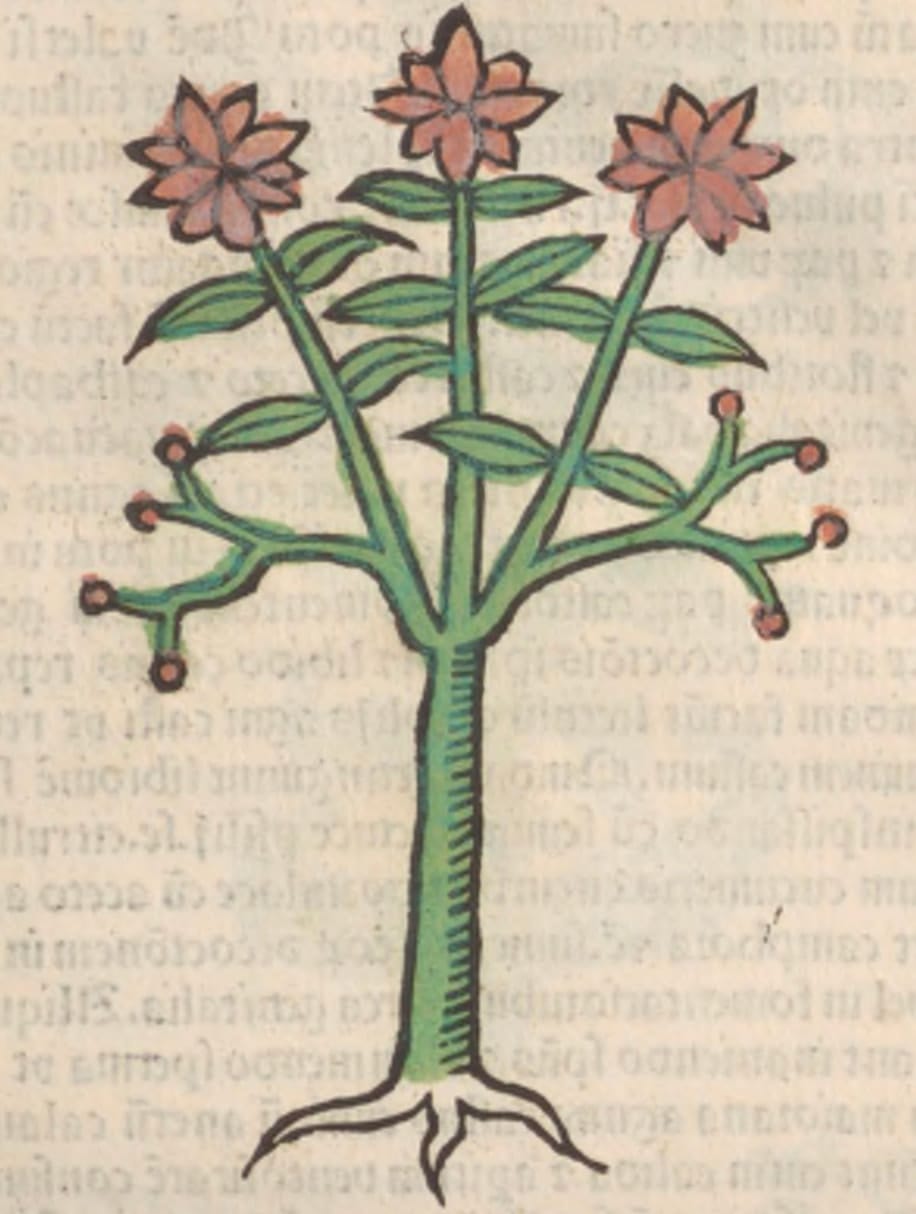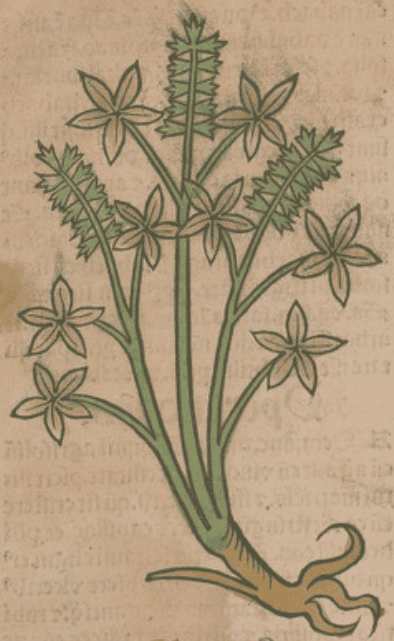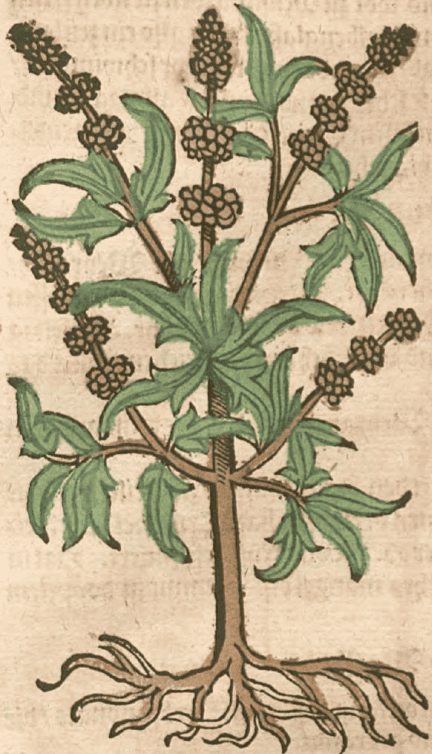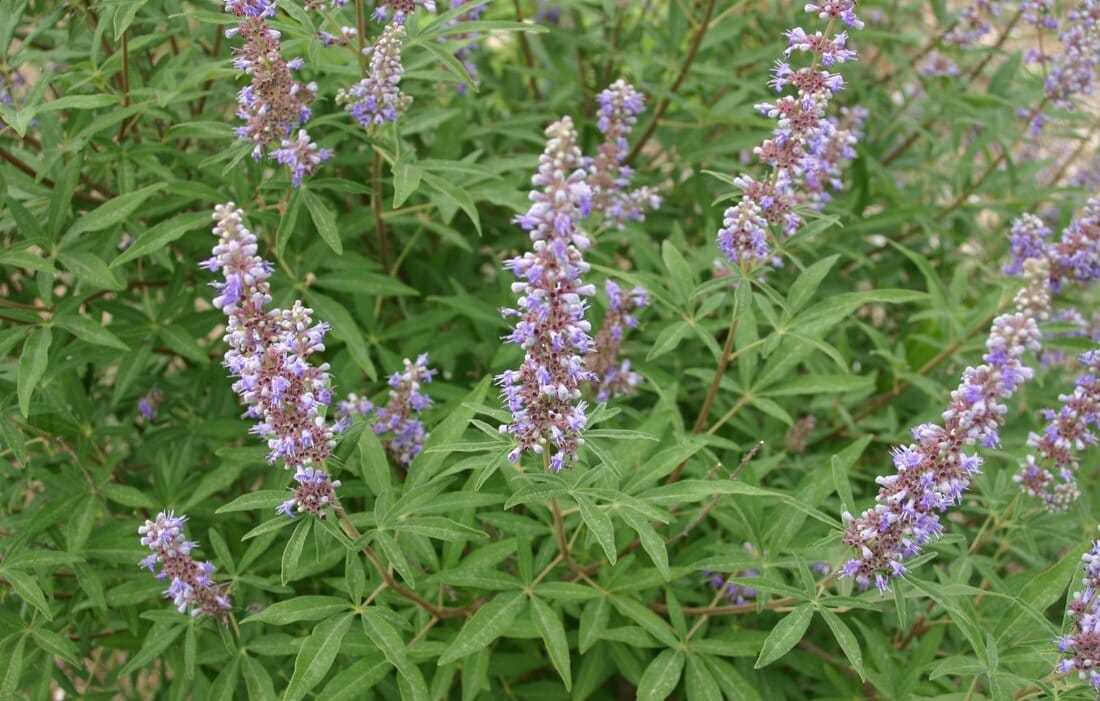Agnus Castus, Chaste treeMonk’s Pepper Tree, Hemp TreeRenuka (Ayurveda) Sambhalu (Unani) |

|
 Herbarius latinus, Petri, 1485
Herbarius latinus, Petri, 1485
 Ortus Sanitatis, Meydenbach, 1491
Ortus Sanitatis, Meydenbach, 1491 |
 Krauterbuch, Lonitzer, 1578
Krauterbuch, Lonitzer, 1578 |
 Vitex agnus castus
Vitex agnus castusDuhamel du Monceau, H.L., Traité des arbres et arbustes, Nouvelle édition, 1815
 Vitex agnus castus
Vitex agnus castus(Photo by Sten Porse) (Wikimedia)
Botanical name:
Vitex agnus castus
Vitex negundo is used in TCM and Ayurveda
Parts used:
Seeds; leaves have similar effect, but are weaker
Temperature & Taste:
Warm, dry; Bitter, pungent
“Hot in the first and Dry in the second degree”. (Avicenna)
Classifications:
2A APERIENT MEDICINES. 2C INCIDERS. 2K. RESOLVENT
3G. EMMENAGOGUE. 3H. LACTAGOGUE
4f. SPLENETIC. 4i. UTERINE
Uses:
1. Moves Qi, Regulates Menstruation:
-Hysteria and various Menstrual disorders; PMS; Menopausal disorders
-Irregular bleeding, Amenorrhea,, decreased menstrual flow
-Menstrual or Uterine Pain (taken with wine)
-Infertility
-Fibroids and Cysts of the Uterus; Hardness, Abscess or Ulcers of the Uterus
-Traditionally to cleanse the Afterbirth.
2. Moves Qi, Opens Obstructions:
-Spleen obstruction or hardness (since Hippocrates)
-hardness and masses of other organs including Uterus
-“A dose of two dirham (7 gm.) with Oxymel, is very useful in hardness of the Spleen”. (Avicenna)
3. Guides Qi Down, Calms the Mind:
-‘it affects the head inducing deep sleep’ (Dioscorides)
–Salmon listed it for Frenzy and Lethargy; related V. negundo has been used in Ayurveda for Psychosis and Drug Withdrawal
4. Warms and Strengthen the Kidneys:
-Premature Ejaculation, Impotence, Spermatorrhea
-Edema, Lumbago, Paralysis
-both provokes and hinders Lust (provokes by stimulating in the short term, hinders Lust by ‘consuming’ the seed in the long term; small doses hinder, large doses promote)
5. Promotes Milk
-Promotes Breast Milk (Pliny)
6. Resists Poison:
-Sudorific and Febrifuge (Pliny)
-classically for Venomous Bites including Snake Bite (Dioscorides)
-“when taken in a dose of one dirham (3.5 gm.), is useful in Snake-bite”. (Avicenna)
7. Externally:
-classically for Trauma and Inflammations (since Hippocrates)
-“employed with salt, nitre, and wax, it is good for sprains”. (Pliny)
-Hard Swellings and Tumors
-“pounded and used with barley-meal, it quickly brings abscesses and hard tumours to a head”. (Pliny)
-“The seed, in combination with Saltpetre and Vinegar, removes Lichens and Freckles”. (Pliny)
-“whitens and clears the complexion”. (Avicenna)
-“mixed with honey, it heals ulcers and eruptions of the Mouth”. (Pliny)
-leaves boiled in wine for mouth Sores and Ulcers (Lonicerus)
-hardness of the Testicles (leaves, Dioscorides)
-“applied with butter and vine-leaves, it reduces swellings of the Testes”. (Pliny)
-“The seeds are used as a plaster with clarified butter in the hardness of Testicles”. (Avicenna)
-decoction used as a wash for tumors of the Genitals (Lonicerus)
-Anal Fissures (Dioscorides)
-“with water, as a liniment, it cures chaps of the Rectum”. (Pliny)
-“decoction of the seed used as a fomentation cures headache, however intense it may be”. (Pliny)
-decoction can be used as a wash over the genitals to restrain lust (Arnold de Villa Nova)
-repels various insects
Dose:
1. Small doses (50-150mg daily) may cause a decrease in sexual desire in men, while moderate doses (500–1000mg daily) can increase sexual desire and treat Impotence and Sterility.
2. In women, it is often used from ovulation through to the beginning of menstruation. Estrogenics can be given in the first half of the cycle.
INFUSION or DECOCTION of the SEED: 1–3 grams as a low dose, 3–6 grams as a large dose;
Of the TINCTURE (1:5 in 45% alcohol): 1–3, or 4 mls;
Of the TINCTURE (90 grams per liter, 60% alcohol): 20–40 drops
Of the SEED in powder: 200mg–2 grams, 3 times daily, often taken with wine. Salmon said the dose is ½–1 dram.
One dram (3 gram) doses of the Seed were used for Snake bite, or 2 drams of the young leaves.
Preparation:
According to Avicenna, it can cause Headache. This can be alleviated by roasting (or dry-frying) the Seeds.
Comment:
1. Agnus Castus and the Vitex species used in Ayurveda and TCM have quite different uses. However, it is quite likely that they are therapeutically similar. However, due to their radically different uses, we have chosen to separate them as 2 different herbs. See Vitex nirgundi
2. “One of the drugs which increase the Milk but decrease the Semen”. (Avicenna)
Main Combinations:
Gynecology:
1. To promote Menstruation, combine Agnus Castus with Pennyroyal (Dioscorides, Gerard)
2. Excess Menstruation, Leukorrhea: combine Agnus Castus with Lettuce seed, Pomegranate seed, Rose, Armenian Earth (as in Troches of Agnus Castus)
3. Premenstrual Syndrome, Hysteria:
i. Agnus Castus, St. John’s wort, Balm
ii. Agnus Castus, Cyperus rotundus, Peony
iii. Agnus Castus with Rue, Peony, Fennel seed, Cinnamon, Rosemary (as in Powder for Hysteria with Agnus Castus)
4. Menopause:
i. Agnus Castus, Nigella, Fenugreek
ii. Agnus Castus, Sage, St. John’s wort
5. Uterine Diseases from Cold and Moist, Agnus Castus with Cyperus, Hyssop, Mugwort, Ameos, Long Pepper, Cassia wood
6. Uterine Fibroids, Agnus Castus, Savin, Madder, Rue, Myrrh, Saffron
7. Polycystic Ovary Syndrome:
i. Agnus Castus, Linseed, Cinnamon, Licorice (Picolin, a Unani remedy)
ii. Agnus Castus, Fenugreek, Cinnamon, Frankincense
8. Leukorrhea, Agnus Castus with Rue, Fennel, Cinnamon (as in Powder for Leukorrhea)
9. Infertility:
i. Agnus Castus with Peony root, Coriander seed, Myrtle berries and Conserve of Rose (as in Electuary Against Sterility)
ii. Agnus Castus, Angelica, Vervain, Cinnamon
iii. Agnus Castus, Pearl, Amber, Saffron
10. Female tonic, and to regulate hormones:
i. Agnus Castus with Motherwort
ii. Agnus Castus with Dang Gui
Male disorders:
11. Spermatorrhea:
i. and to Quell Lust, Agnus Castus with Conserve of Water Lily, Lettuce, Red Coral, Camphor
ii. Agnus Castus with Mint, Orris root, Rue seed, Lettuce seed (as in Pulvis Gonorrheam)
iii. Agnus Castus with Bistort, Tormentil, Water Lily root, Lettuce seed, Rue seed, Amber, Mastic
12. To restrain Lust, Agnus Castus with Lettuce seed, 4 Greater Cold Seeds, Purslane, Camphor; decoct and forment the genitals (Arnold de Villa Nova)
Urinary:
13. Edema:
i. Agnus Castus decocted in wine (Herbarium Horstianum, 1630)
ii. Agnus Castus with Fennel seed
iii. Agnus Castus with Oxymel (Arnold de Villa Nova)
Obstructions & Tumors
14. Hardness of the Liver or Spleen (Cirrhosis):
i. take a dram of Agnus Castus seed with Cumin in Fennel water (Wirtzung)
ii. Agnus Castus, Capers root-bark, Endive seed (equal parts)
iii. Agnus Castus with Agrimony, Licorice juice, Asarum, Senna, Rhubarb, Purslane seed, Rose, Indian Spikenard, Cyperus (as in Troches for Hardness of the Liver)
iv. Agnus Castus with Scarlet pimpernel, Indian Spikenard, Asarum, Senna Purslane seed, Rose, Tabasheer (as in Troches Proven for Hardness of the Liver)
v. Agnus Castus with Caper root bark, Pepper, Asarum, Orris root, Spikenard, Saffron (as in Troches of Capers Root-bark)
15. Obstruction of the Liver and Spleen, decoct Agnus Castus with Scolopendrum, Wormwood and Licorice in wine. (Arnold de Villa Nova)
16. Hardness of the Stomach or Spleen, Agnus Castus with Marshmallow root, powder, mix with oil and wine and apply (Arnold de Villa Nova)
17. Tumor or Hardness of the Testicles:
1. from Cold, Agnus Castus with Fenugreek, Orris, Cumin, Chickpea (form a tincture with wine) (Antidotarium medico chymicum reformatum, 1620)
ii. apply Agnus Castus with butter and Grape leaf. (Dioscorides; Dorsten, 1540)
Brain, Mind, Spirit:
18. Lethargy, Agnus Castus, Celery seed, Sage, decoct in salt water and wash the back of the head. It cures immediately. (Dorsten, 1540)
19. Hypochondriac Melancholy, Agnus Castus leaf and seed decocted. (Herbarium Horstianum, 1630)
Other:
20. As a laxative, Agnus Castus seed with Pennyroyal, taken in drink with Honey. (Pliny)
Major Formulas
Syrup of Agnus Castus Compound
Troches of Agnus Castus
Troches Praised for the Liver, Spleen and Stomach
Powder for Hysteria with Agnus Castus
Powder for Spermatorrhea
Powder to Quell Excess Lust (Nicholas)
Confection for a Cold and Moist Uterus
Cautions:
1. Avoid overdose.
2. Best not used in children.
3. Should not be used during pregnancy (but is safe during lactation).
4. In clinical trials using Agnus Castus, Nausea and abdominal pain were the main reported adverse effects. Some women (1-2%) have noted itchiness, rash, heavier menstruation, headaches or breast tenderness after its use.
5. Vitex agnus castus: a systematic review of adverse events.
Drug Interactions:
1. Use carefully or not at all in women on the Pill, or who are taking HRT as it may counteract them.
2. Because of its dopaminergic effect, it may interact or antagonise drugs attaching to dopamine receptors.
3. Should not be used with Antipsychotics.
Main Preparations used:
Troches of Agnus Castus, Tincture
1. TINCTURE of VITEX AGNUS.
Agnus seed 90 grams
Alcohol (60%) 1 liter
Form a tincture. This is the standard preparation used in Europe, and this is very similar to most of the extracts which have been researched in Europe.
Dose: 20-40 drops, 1-2 times daily.
Pliny on Vitex:
|
‘Not much unlike the willow, for the use that is made of it in wicker-work, is the vitex, which also resembles it in the leaves and general appearance, though the smell of it is more agreeable. The Greeks call it “lygos,” or “agnos,” from the fact that the matrons of Athens, during the Thesmophoria, a period when the strictest chastity is observed, are in the habit of strewing their beds with the leaves of this tree. ‘There are two species of vitex: the larger one, like the willow, attains the full proportions of a tree; while the other, which is smaller, is branchy, with a paler, downy leaf. The first kind, generally known as the ” white ” vitex, bears a white blossom mixed with purple, whereas the black one has a flower that is entirely purple. Both of these trees grow on level spots of a marshy nature. ‘The seed of these trees, taken in drink, has a sort of vinous flavour, and has the reputation of being a febrifuge. It is said also to act as a sudorific, if the body is rubbed with it mixed with oil, and to have the effect of dispelling extreme lassitude: it acts too as a diuretic and emmenagogue. The produce of both trees is trying to the head, like wine, and indeed the odour of them is very similar. They have the effect also of removing flatulence in the lower regions of the body, act astringently upon the bowels, and are remarkably useful for dropsy and affections of the spleen. They promote the secretion of the milk, and neutralize the venom of serpents, when of a cold nature more particularly. The smaller kind, however, is the more efficacious of the two for injuries inflicted by serpents, the seed being taken in doses of one drachma, in wine or oxycrate, or else the more tender leaves in doses of two drachma. |
‘From both trees also a liniment is prepared for the bites of spiders, but it is quite sufficient to rub the wounds with the leaves; and if a fumigation is made from them, or if they are spread beneath the bed, they will repel the attacks of all venomous creatures. They act also as an antaphrodisiac, and it is by this tendency in particular that they neutralize the venom of the phalangium, the bite of which has an exciting effect upon the generative organs. The blossoms and young shoots, mixed with oil of roses, allay headaches arising from inebriation. A decoction of the seed used as a fomentation cures headache, however intense it may be; and employed as a fumigation or as a pessary, the seeds acts as a detergent upon the uterus. Taken in drink with honey and pennyroyal, it has a laxative effect; pounded and used with barley-meal, it quickly brings abscesses and hard tumours to a head, and has an emollient effect. ‘The seed, in combination with saltpetre and vinegar, removes lichens and freckles; mixed with honey, it heals ulcers and eruptions of the mouth; applied with butter and vine-leaves, it reduces swellings of the testes; used with water, as a liniment, it cures chaps of the rectum; and employed with salt, nitre, and wax, it is good for sprains. The seed and leaves are used as ingredients also in emollient plasters for diseases of the sinews, and for gout; and a decoction of the seed in oil is employed as a fomentation for the head in cases of phrenitis and lethargy. Persons who carry a sprig of this plant in the hand, or stuck in the girdle, will be proof, it is said, against chafing between the thighs.’ (The Natural History of Pliny, trans. by Bostock and Riley, Vol. 5, 1856) |
